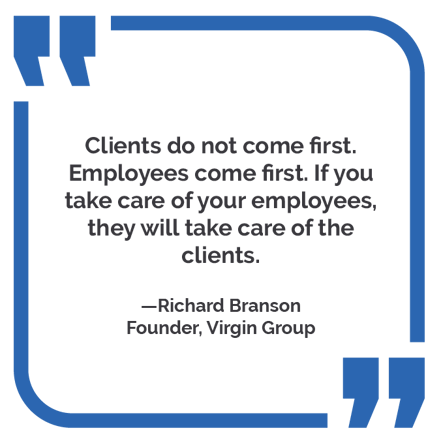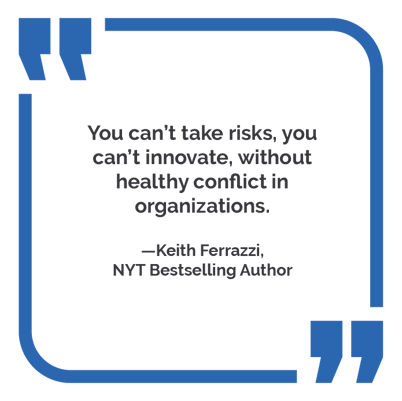Why The New World Of Work Calls For A Team-First Approach


If you’re designing one-size-fits-all programs to address your company’s productivity needs, you’re taking the peanut butter approach.
At least, that’s how it looks to HR and culture guru Keith Ferrazzi.
He compares this enterprise-wide programming to spreading a thin layer of peanut butter over a large piece of bread. That way of doing things doesn’t address the individual personalities and needs of your employees.
And it certainly doesn’t work in today’s forever-changed workplace.
If you want to effectively tackle the needs of your growing company, you need a more surgical approach. You need to focus on your teams.
6 Signs Of A Healthy Workplace Team
In a recent Growth Institute webinar, Keith shared his workplace culture wisdom.
His guidance, from his book “Competing In The New World Of Work,” is especially valuable now. Everyone is struggling to build strong organizations while also managing remote/hybrid work and staffing challenges.
After all, the secret to a successful business starts with people.
As Richard Branson says,
“Clients do not come first. Employees come first. If you take care of your employees, they will take care of the clients.”
So how can you make sure you’re addressing employee needs with an approach that’s more targeted?
This was a tall order even before the COVID-19 pandemic.
But it’s possible. You can ensure your company is focusing on productive teams, no matter where employees are located and when they are working.
Keith recommends starting by encouraging these 6 team competencies—all signs of a healthy workplace culture.
1. Practice Candor
Can your teams challenge each other, even when it’s risky to do so?
And where do they have those tough conversations, if at all? If they’re happening in the hallway after the meeting, what does that mean for remote employees?
Instead of embracing conflict avoidance, establish a team contract that encourages transparency and, when necessary, respectful conflict among teams.
Put the contract to paper.
This willingness to be open and honest as a group makes it easier for team members to speak up and take risks. And that encourages innovation.
2. Ensure Accountability
Successful teams are accountable to more than just the leader.
They’re accountable to each other. To foster a culture of accountability, Keith suggests something he calls “bullet-proofing sessions”.
These meetings include reports from individual team members, but the reports are more than just the typical updates about what employees are working on. The updates also include information about what team members are struggling with. By encouraging employees to be open about their challenges, you make it OK for them to not be perfect.
After hearing an employee outline their challenge, open the floor for suggestions about how that team member might tackle the problem.
Break your team into smaller groups to discuss ideas. If you’re remote, open breakout rooms in your video meeting. Teams can start an online document to track their recommendations and ideas for support, sharing that document to help the employee overcome the issue and stay on track in their work.
3. Facilitate Collaboration
Lots of companies equate collaboration with meetings.
Keith recommends making use of the technologies we all came to rely on during the pandemic to go beyond the collaboration-as-meeting model.
And why not?
He says that in a typical meeting of 12 people, only 4 believe they’re really heard. Correct the problem by starting the collaboration before the meeting. Open a shared document that outlines discussion points and gives team members the opportunity to note ideas and suggestions.
This way you don’t have to be in the same room or even on the same continent. You don’t have to engage in a discussion at the same time or even on the same day.
You’re still encouraging participation and facilitating collaboration that extends beyond a formal meeting.
4. Become Agile
The agile workflow is common in technology teams, but Keith suggests adopting this mindset no matter what type of business you’re operating. If your teams are agile, they’re working toward objectives in increments that allow for adjustment along the way.
When employees or teams complete an increment of work toward achieving a goal, pause and evaluate. Consider whether the work was successful and the objective makes sense. Then adjust expectations about key results and the work required to achieve those outcomes.
The completion of each increment of work offers an opportunity to focus on some of the other signs of a healthy culture, like offering transparent feedback and holding each other accountable.
5. Use Foresight
“Volatile” is how Keith describes this new world of work. And, yes, our business climate and work lives seem to change by the day.
Simply reacting to these shifting forces will put you behind other organizations. 
By looking around corners to anticipate what’s coming, you can help your teams develop practices and innovations that get them in front of changing trends. Each recognition of change presents a chance for teams to collaborate to prepare themselves—and your organization—for what’s to come.
6. Foster Resilience
The days of treating employees’ well-being as separate from their work are over. The pandemic brought out a level of vulnerability and concern for each other unprecedented in the business world.
Today’s employees expect to bring their full selves to work. That means being open about the things in their lives that are causing stress, whether it’s a perplexing work problem or mental health concerns.
Encourage openness and resilience by allowing your own vulnerability to show through. If you’re anything less than authentic, you run the risk of exacerbating employees’ problems.
And you’ll likely watch those employees leave for more supportive companies.
Scale Your Business The Team-First Way
It’s time to move away from the peanut butter approach to managing your business’ productivity.
Instead of spreading your efforts across your entire enterprise, zero in on its teams.
Commit each team to using candor, accountability, collaboration, an agile process, foresight, and resilience.
It won’t always be easy.
You’ll encounter some pushback as you work to overcome old mindsets and behaviors. But if you partner with your fellow leaders and align your team-first approach to the bigger vision, you’ll increase your odds of success.
And you’ll become a transformational agent in your organization.
Discover More Workplace Culture Tips
Ready to learn more from Keith Ferrazzi about how to increase productivity and strengthen your company’s culture? I encourage you to watch “The Roadmap To The New World Of Work.”
The webinar features Keith’s insight as well as tips from our thought leader Verne Harnish for building a corporate university to facilitate team learning.



